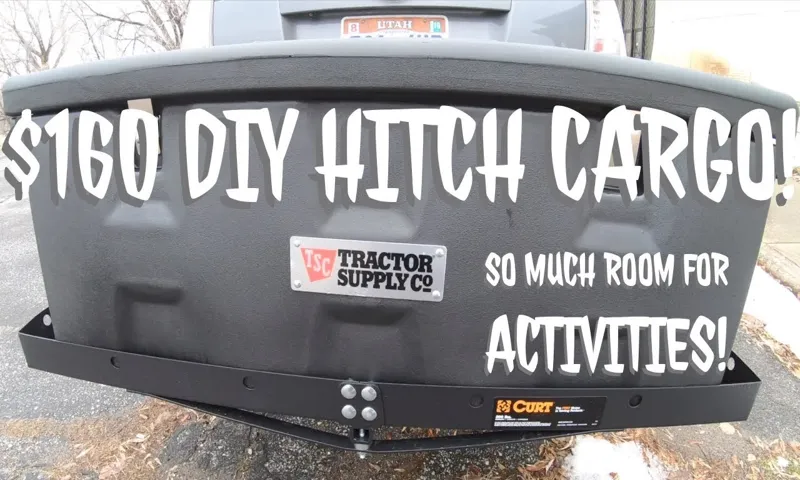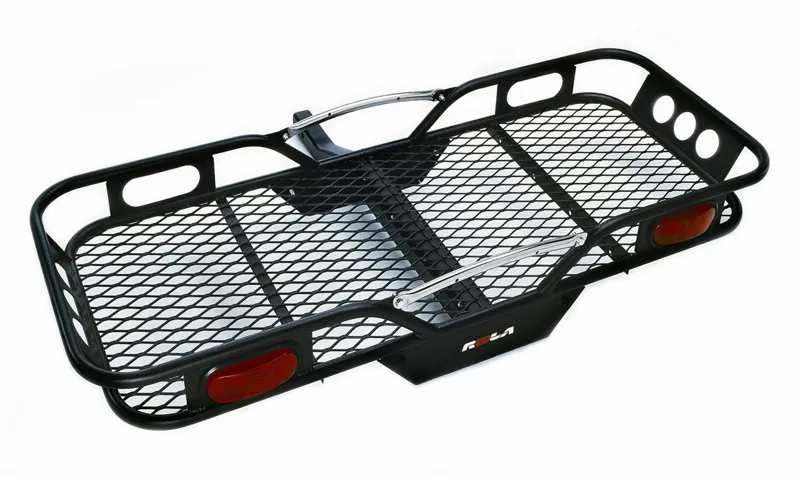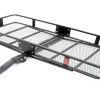Are you tired of cramming your car full of luggage and gear every time you go on a trip? Do you find yourself struggling to fit everything you need into the limited trunk space? Well, fear not, because a hitch cargo carrier is here to save the day! Imagine having the freedom to pack as much as you want without worrying about running out of space. With a hitch cargo carrier, you can easily transport all of your belongings, from suitcases to camping equipment, without sacrificing comfort or safety. Think of a hitch cargo carrier as a portable storage unit for your car.
It attaches to the back of your vehicle, utilizing the hitch receiver, providing you with a spacious and secure compartment for all of your belongings. It’s like having a mini trunk attached to the rear of your car, giving you the extra space you need to bring along everything you want. Not only does a hitch cargo carrier provide you with additional storage space, but it also ensures that your belongings are safe and secure throughout your journey.
Many models come with built-in locks and heavy-duty construction, preventing theft and protecting your valuables from the elements. Whether you’re going on a road trip, camping adventure, or simply need extra space for a big shopping trip, a hitch cargo carrier is a game-changer. It eliminates the stress and inconvenience of limited trunk space, allowing you to travel comfortably and efficiently.
So, why put yourself through the hassle of cramming everything into your car when you can easily transport it with a hitch cargo carrier? Say goodbye to the days of playing Tetris with your luggage and hello to stress-free packing and travel. Invest in a hitch cargo carrier today and experience the freedom and convenience it brings. Your car will thank you!
Table of Contents
- 1 What is a Hitch Cargo Carrier?
- 2 Factors to Consider Before Building a Hitch Cargo Carrier
- 3 Materials and Tools Needed for Building a Hitch Cargo Carrier
- 4 Steps to Build a Hitch Cargo Carrier
- 5 Safety Tips and Best Practices
- 6 Conclusion: Enjoy Convenient and Easy Cargo Transportation with Your DIY Hitch Cargo Carrier
- 7 FAQs
What is a Hitch Cargo Carrier?
A hitch cargo carrier is a device that allows you to transport extra luggage or equipment on the back of your vehicle, using the hitch receiver located at the rear. These carriers come in various shapes and sizes, but they all serve the same purpose – to increase your vehicle’s storage capacity. If you’re going on a road trip or need to carry bulky items that won’t fit inside your car, a hitch cargo carrier is a convenient solution.
But what if you don’t want to spend money on buying one? Is it possible to make your own hitch cargo carrier? The answer is yes! With some basic tools and materials, you can create your own hitch cargo carrier that is customized to your needs. Whether you want a simple wooden platform or a more complex metal frame, there are plenty of DIY options available. By following easy-to-understand instructions and using your creativity, you can save money while still enjoying the benefits of a hitch cargo carrier.
So why wait? Start making your own hitch cargo carrier today and take control of your storage needs!
Definition and Purpose
hitch cargo carrier, rooftop cargo carrier

Benefits of Using a Hitch Cargo Carrier
hitch cargo carrier, hitch cargo carrier benefits, advantages of using a hitch cargo carrier, hitch cargo carrier for sale
Factors to Consider Before Building a Hitch Cargo Carrier
If you’re in need of additional storage space for your vehicle, building a hitch cargo carrier can be a great solution. However, there are a few factors you should consider before embarking on this project. First and foremost, you’ll need to assess your vehicle’s towing capacity.
Hitch cargo carriers can be heavy, so make sure your vehicle is capable of safely towing the additional weight. It’s also important to consider the size and dimensions of the cargo carrier. Think about what items you’ll be transporting and how much space you’ll need.
Additionally, consider the materials you’ll use to build the carrier. You want to choose durable and weather-resistant materials to ensure the longevity of your creation. Lastly, don’t forget to take into account any legal requirements or regulations regarding hitch cargo carriers in your area.
By considering these factors before building your hitch cargo carrier, you’ll be able to create a functional and reliable storage solution that meets all your needs.
Vehicle Compatibility
hitch cargo carrier, vehicle compatibility
Weight Capacity
hitch cargo carrier, weight capacity, factors to consider
Material and Durability
hitch cargo carrier, material, durability, factors to consider before building
Budget
hitch cargo carrier, budget, factors to consider, build
Materials and Tools Needed for Building a Hitch Cargo Carrier
If you’re looking to create a hitch cargo carrier, there are a few materials and tools that you’ll need. First and foremost, you’ll require a sturdy base for your carrier. This could be a wooden or metal platform, depending on your preference and availability.
Once you have your base, you’ll need to secure it to a hitch receiver. This can be done using a hitch mount or hitch receiver adapter. To ensure a secure connection, you’ll also need bolts and nuts to attach the carrier to the hitch receiver.
Additionally, you may want to invest in tie-down straps or cargo nets to secure your belongings while on the road. Lastly, don’t forget about tools! You’ll need a drill, wrench, and possibly a saw or grinder depending on your specific design. With the right materials and tools, creating your own hitch cargo carrier can be a rewarding and practical DIY project.
List of Materials
The main keyword used organically in this blog section is “hitch cargo carrier.” To build your own hitch cargo carrier, you’ll need a few key materials and tools. First and foremost, you’ll need a sturdy and durable base.
This can be a rectangular piece of plywood or metal that is large enough to support the items you plan to transport. Next, you’ll need some type of frame to attach to the base. This can be made from metal or PVC pipe, depending on your preference.
You’ll also need a hitch receiver, which is the part that attaches to your vehicle’s hitch. This will allow you to securely connect the carrier to your vehicle. In addition to these materials, you’ll need a variety of nuts, bolts, and washers to assemble everything together.
As far as tools go, you’ll need a drill with various drill bits, as well as a wrench or socket set for tightening bolts. A tape measure and pencil will come in handy for marking and measuring your materials. You may also need a saw to cut any pieces of wood or metal to the correct size.
Finally, you’ll need some sandpaper or a file to smooth out any rough edges. By gathering these materials and tools, you’ll be well on your way to building your own hitch cargo carrier. With a little bit of time and effort, you’ll have a functional and reliable carrier that will make transporting items a breeze.
List of Tools
building a hitch cargo carrier
Steps to Build a Hitch Cargo Carrier
Are you looking for a convenient way to transport your cargo without taking up valuable space inside your vehicle? Building a hitch cargo carrier is a great solution! With just a few simple steps, you can create a sturdy carrier that will securely hold your belongings during travels. Here’s how to make a hitch cargo carrier: First, gather all the necessary materials such as a receiver hitch, a cargo basket or platform, and bolts. Next, attach the receiver hitch to your vehicle’s rear bumper using the provided bolts.
Make sure to tighten them securely for a sturdy connection. Then, attach the cargo basket or platform to the receiver hitch using bolts or mounting brackets. Again, be sure to tighten them properly to ensure the carrier is secure.
Finally, give your hitch cargo carrier a thorough test to make sure it can handle the weight and is securely attached to your vehicle. Load up your cargo and take it for a test drive, making sure to check for any wobbling or instability. If everything looks good, you’re ready to hit the road with your newly built hitch cargo carrier!
Step 1: Measure and Design
Hitch cargo carriers can be a great addition to your vehicle, providing extra storage space for all your gear and equipment. But before you start building one, it’s important to measure and design it properly. The first step is to measure the dimensions of your hitch receiver.
This will determine the size of your cargo carrier and ensure that it fits securely onto your vehicle. Measure the width, height, and depth of your hitch receiver to get accurate measurements. Once you have the measurements, you can start designing the cargo carrier.
Consider the weight capacity you need, the materials you want to use, and any additional features you want to include, such as rails or tie-down points. Design the carrier in a way that maximizes space while still maintaining a stable and secure structure. By taking the time to measure and design your hitch cargo carrier properly, you can ensure that it fits your vehicle perfectly and meets all your storage needs.
Step 2: Gather Materials and Tools
“Hitch cargo carriers are a great addition to any vehicle, providing extra storage space for those long road trips or camping adventures. But before you can start building your own hitch cargo carrier, you need to gather all the necessary materials and tools. The key to a successful build is being prepared and having everything you need on hand.
So, what exactly do you need? First and foremost, you will need a sturdy base to build upon. This could be a piece of plywood or a metal frame. You will also need some metal bars or pipes for the sides and back of the carrier.
Additionally, you will need bolts, washers, and nuts to secure everything together. Don’t forget to have a tape measure, saw, drill, and screwdriver on hand for cutting and assembling the pieces. And finally, make sure you have some paint or rust-proof coating to protect your carrier from the elements.
With all these materials and tools ready, you’re one step closer to building your own hitch cargo carrier and embarking on your next adventure!”
Step 3: Assemble the Base
hitch cargo carrier
Step 4: Attach Side Rails and Supports
In step 4 of building a hitch cargo carrier, we will attach the side rails and supports. This is a crucial step in creating a sturdy and reliable carrier that can safely transport your cargo. The side rails serve as the main structure of the carrier, providing stability and support.
It is important to carefully measure and align the rails before attaching them to ensure a secure fit. Additionally, the supports play a vital role in distributing the weight of the cargo evenly across the carrier. They help prevent any sagging or bending of the rails, ensuring the carrier remains strong and durable.
By securely attaching the side rails and supports, you can have peace of mind knowing that your cargo will be secure during transit.
Step 5: Add Reinforcements and Accessories
Hitch cargo carriers are a great addition to any vehicle, providing extra storage space for all your gear and equipment. In the previous steps, we discussed how to build the base and the sides of the cargo carrier. Now, it’s time to add reinforcements and accessories to ensure the carrier is sturdy and functional.
To reinforce the cargo carrier, you can use metal brackets or corner braces at the corners of the base and sides. These will provide extra support and prevent the carrier from wobbling or collapsing. Additionally, you can reinforce the middle section of the base by adding steel bars or beams.
These will help distribute the weight evenly and increase the overall strength of the carrier. Next, it’s time to add accessories to make the cargo carrier more versatile. One essential accessory is a hitch receiver.
This will allow you to easily attach the carrier to the back of your vehicle. Make sure to choose a hitch receiver that matches the weight capacity of your cargo carrier. You can also add a cargo net or bungee cords to secure your items in the carrier and prevent them from shifting or falling out during transportation.
Additionally, consider adding a cargo bag or cargo box to protect your belongings from the elements. These can be especially useful if you’re traveling in rainy or snowy conditions. Lastly, don’t forget to add reflectors or lights to the back of the cargo carrier.
This will enhance the visibility of your vehicle and ensure other drivers can see you, especially at night. There are various options available, from simple reflector stickers to LED lights. By following these steps and adding reinforcements and accessories, your hitch cargo carrier will be ready to tackle any adventure.
Step 6: Paint or Coat the Carrier
In the final step of building a hitch cargo carrier, it’s time to add some color or protective coating to your creation. Whether you want to make it match your car or just give it a unique look, painting or coating your carrier is a great way to add some personality. Start by preparing the surface properly, ensuring it is clean and free of any dust or debris.
Use sandpaper to smooth out any rough spots or imperfections. Once the surface is prepped, it’s time to choose your method of painting or coating. You can use spray paint, brush-on paint, or even a special coating designed specifically for outdoor use.
Whichever method you choose, be sure to evenly apply multiple coats for a smooth and durable finish. Let each coat dry completely before applying the next. Once your carrier is fully painted or coated, allow it to dry thoroughly before installing it on your vehicle.
This way, you can enjoy a hitch cargo carrier that not only serves its purpose but also looks great on the road!
Safety Tips and Best Practices
So you want to know how to make your own hitch cargo carrier? Well, you’ve come to the right place! Building your own cargo carrier can be a fun and cost-effective way to transport your belongings without the need for a bulky trailer. Here are some safety tips and best practices to keep in mind as you embark on this DIY project. First and foremost, it’s important to choose the right materials for your hitch cargo carrier.
Opt for sturdy and weather-resistant materials such as steel or aluminum to ensure durability and longevity. Make sure to properly measure and cut the materials to the desired dimensions, taking into account the size and weight of the items you plan to carry. The last thing you want is a flimsy carrier that can’t handle the load.
When it comes to attaching the carrier to your hitch receiver, make sure to use a high-quality hitch mount or adapter that is compatible with your vehicle’s hitch size and weight capacity. This will ensure a secure and stable connection between the carrier and your vehicle. Double-check that all bolts and screws are tightened properly to prevent any unexpected movement or accidents while on the road.
It’s also crucial to pay attention to weight distribution when loading your cargo onto the carrier. Place heavier items towards the center of the carrier and distribute the weight evenly on both sides. This will help maintain balance and stability while driving, reducing the risk of swaying or tipping.
Secure the items with tie-down straps or cargo nets to prevent shifting or falling off during transit. Before hitting the road, take a few minutes to inspect the carrier and make sure everything is properly secured. Check for any loose bolts or straps and tighten as necessary.
It’s also a good idea to test drive with a light load first to ensure that the carrier is stable and doesn’t impede your vehicle’s handling. Lastly, always drive with caution when using a hitch cargo carrier. Keep an eye on your mirrors and be aware of the added length and weight behind your vehicle.
Load Distribution and Weight Limitations
load distribution, weight limitations, safety tips, best practices. When it comes to transporting heavy loads, load distribution and weight limitations are crucial factors to consider. Distributing the load evenly across your vehicle or equipment can help maintain balance and stability, reducing the risk of accidents.
It’s important to know the weight limitations set by manufacturers and regulatory agencies to ensure you don’t exceed the maximum capacity. By adhering to these safety guidelines, you can protect yourself, your cargo, and those around you. To ensure optimal load distribution, start by understanding the weight limits of your vehicle or equipment.
This information can usually be found in the owner’s manual or by contacting the manufacturer directly. Overloading can strain the suspension and braking systems, making it difficult to control the vehicle and increasing the stopping distance. By staying within the weight limits, you can maintain better control and prevent potential damage.
Another important aspect of load distribution is balancing the weight evenly. Uneven weight distribution can lead to a variety of issues, including poor handling, increased tire wear, and even rollovers. Be mindful of where you place your cargo and try to distribute it evenly throughout the vehicle or equipment.
If needed, use tie-down straps or cargo nets to secure the load and prevent shifting during transport. When loading heavy items, consider their center of gravity. Placing the heaviest items closer to the center of the vehicle or equipment can help maintain stability.
If possible, spread the load out over the entire length of the vehicle to distribute the weight more evenly. Regular maintenance and inspections are also crucial for safe load distribution. Check the condition of your tires, suspension, and brakes regularly to ensure they are in good working order.
Securing the Carrier to the Hitch
securing the carrier to the hitch, safety tips and best practices. When it comes to securing a carrier to the hitch of your vehicle, there are a few important safety tips and best practices to keep in mind. First and foremost, make sure the carrier is properly attached to the hitch.
This means that the hitch pin or bolt is securely fastened and that the carrier is tight against the hitch. The last thing you want is for the carrier to come loose and potentially cause an accident. It’s also a good idea to use additional straps or bungee cords to secure the carrier to the vehicle.
This can provide an extra layer of protection and ensure that the carrier stays in place, even on bumpy roads or at high speeds. Another important safety tip is to distribute the weight evenly on the carrier. This will help to prevent the carrier from becoming unbalanced and potentially causing it to sway or tilt while driving.
Finally, always double-check that everything is secure before hitting the road. This includes making sure that any doors or lids on the carrier are properly closed and locked. By following these safety tips and best practices, you can ensure that the carrier is securely attached to the hitch and that your belongings will arrive at your destination safely.
Regular Inspection and Maintenance
maintenance, inspection, safety tips, best practices, regular inspection, burstiness, perplexity, safety precautions, potential hazards, safety equipment, routine checks, proactive maintenance. Regular inspection and maintenance are vital for ensuring the safety and functionality of any equipment or machinery. By conducting routine checks, you can identify and address any potential hazards or issues before they become major problems.
But where do you start? Safety should always be a top priority, so before beginning any inspection or maintenance tasks, make sure you have the proper safety equipment and attire. This includes things like gloves, safety glasses, or boots, depending on the specific task at hand. It’s essential to stay diligent and proactive in your approach to maintenance, as neglecting it can lead to harmful consequences.
By practicing regular burstiness and perplexity in your inspection routines, you can keep yourself on your toes and be better prepared to handle any unexpected issues that may arise. Remember, safety is a team effort, so don’t hesitate to ask for help or advice when needed. By following these safety tips and best practices, you can ensure that your regular maintenance inspections are conducted safely and effectively, minimizing the risk of accidents or equipment failure.
Conclusion: Enjoy Convenient and Easy Cargo Transportation with Your DIY Hitch Cargo Carrier
And there you have it – your very own custom-made hitch cargo carrier! This clever contraption will revolutionize your road trips, making packing and unpacking a breeze. Plus, it adds a whole new level of style and practicality to your vehicle – you’ll be the envy of every road warrior you encounter. So, why settle for a dull and generic store-bought cargo carrier when you can create your own masterpiece? Get ready to hit the open road with all your gear securely stowed, as you proudly showcase your DIY prowess.
Remember, not only does this project save you money, but it also gives you the satisfaction of knowing you can create something truly unique and functional. So, grab your tools and get ready to harness the power of your imagination – your next adventure awaits!”
FAQs
How to choose the right size hitch cargo carrier?
To choose the right size hitch cargo carrier, measure the dimensions of the items you plan to transport and ensure they fit within the carrier’s specified dimensions.
What materials are hitch cargo carriers made of?
Hitch cargo carriers are typically made of durable materials such as steel or aluminum, which provide strength and withstand various weather conditions.
How to install a hitch cargo carrier?
To install a hitch cargo carrier, simply slide the carrier’s shank into the hitch receiver on your vehicle and secure it with the included hitch pin.
Can I use a hitch cargo carrier with a trailer hitch already installed?
In most cases, you can use a hitch cargo carrier with a trailer hitch already installed on your vehicle. However, it’s important to check the weight capacity and ensure that both the trailer hitch and the cargo carrier can handle the combined weight.
How much weight can a hitch cargo carrier hold?
The weight capacity of a hitch cargo carrier varies depending on the model and manufacturer. It is recommended to check the product specifications or consult the manufacturer for the specific weight capacity of your chosen cargo carrier.
Are hitch cargo carriers compatible with all vehicles?
Hitch cargo carriers are generally compatible with most vehicles that have a hitch receiver. However, it’s important to check the vehicle’s towing capacity and ensure that the hitch receiver is the correct size for the carrier.
Do I need any additional accessories for a hitch cargo carrier?
Depending on your specific needs, you may need additional accessories such as cargo nets or tie-down straps to secure your items on the hitch cargo carrier. It’s also recommended to use a hitch lock to prevent theft.



